Beauty Around the World

How do you define beauty? Is it a small waist and large breasts? A perfect smile and straight hair? If you flip through the pages of an American fashion magazine, you may think beauty is narrowly defined...but that's not the case.
From thick ankles to small noses, women from five continents are revealing what's considered beautiful in their countries. "It's a way of connecting yourselves from your kitchen, your living room, your bedroom ... to the rest of the world," Oprah says.
As a digital correspondent for NBC Nightly News with Brian Williams, Mara Schiavocampo travels the globe, covering stories with just her camera, tripod and laptop. Now, she's heading to Tokyo to see how Japanese women define beauty and find out what measures they'll take to achieve perfection.
From thick ankles to small noses, women from five continents are revealing what's considered beautiful in their countries. "It's a way of connecting yourselves from your kitchen, your living room, your bedroom ... to the rest of the world," Oprah says.
As a digital correspondent for NBC Nightly News with Brian Williams, Mara Schiavocampo travels the globe, covering stories with just her camera, tripod and laptop. Now, she's heading to Tokyo to see how Japanese women define beauty and find out what measures they'll take to achieve perfection.
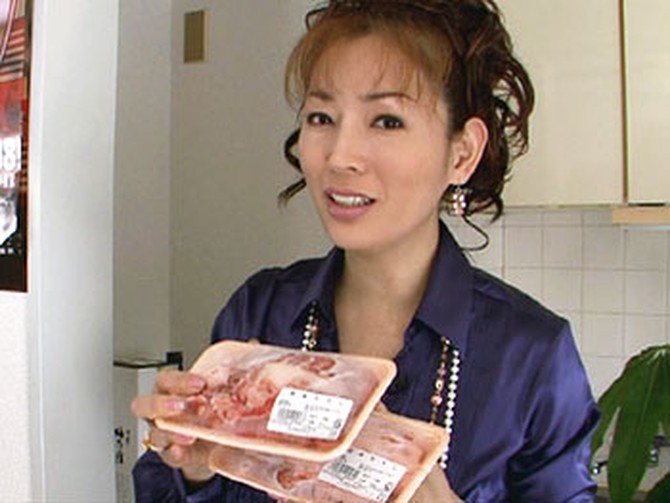
Mara says Japanese women believe their skin is the key to true beauty. Miki Okae, one of Japan's most famous beauty experts, says the ideal is fair, smooth skin. "Everyone demands that," she says.
While some Americans get collagen and Botox injections to erase wrinkles, Japanese women believe in a different approach—they consume collagen-infused foods. Miki says eating collagen-rich beef tendons is a regular part of her beauty routine. "I sneak out of the office when the supermarket opens to buy this," she says.
Many restaurants even feature collagen, which is derived from animals like cows and chickens, on their menus. "Collagen-infused food is everywhere in Japan," Mara says.
Watch Mara's report on Japanese beauty secrets.
Every day for the past five years, Miyuki, a 30-year-old woman living in Tokyo, says she's been drinking a combination of collagen and water to look more youthful. Some days, she mixes the animal product with tea. "It makes my skin beautiful, I guess."
After speaking with women like Miyuki, Mara consults a dermatologist, who says there's no evidence that what you drink or eat will improve sagging skin or erase wrinkles...but that's not deterring millions of Japanese women. "People really swear by it. It makes them feel better," Mara says. "It makes them feel healthier and more beautiful."
One century-old Japanese beauty treatment also relies on an unusual ingredient...nightingale droppings. The bird droppings are made into a powder—known as Uguisu no Fun—mixed with soap and used as a face wash. Mara meets Kamiko and Miki, a mother-daughter pair who swear by this product. At ages 43 and 70, they say bird poop facials are their secret to looking young.
While some Americans get collagen and Botox injections to erase wrinkles, Japanese women believe in a different approach—they consume collagen-infused foods. Miki says eating collagen-rich beef tendons is a regular part of her beauty routine. "I sneak out of the office when the supermarket opens to buy this," she says.
Many restaurants even feature collagen, which is derived from animals like cows and chickens, on their menus. "Collagen-infused food is everywhere in Japan," Mara says.
Watch Mara's report on Japanese beauty secrets.
Every day for the past five years, Miyuki, a 30-year-old woman living in Tokyo, says she's been drinking a combination of collagen and water to look more youthful. Some days, she mixes the animal product with tea. "It makes my skin beautiful, I guess."
After speaking with women like Miyuki, Mara consults a dermatologist, who says there's no evidence that what you drink or eat will improve sagging skin or erase wrinkles...but that's not deterring millions of Japanese women. "People really swear by it. It makes them feel better," Mara says. "It makes them feel healthier and more beautiful."
One century-old Japanese beauty treatment also relies on an unusual ingredient...nightingale droppings. The bird droppings are made into a powder—known as Uguisu no Fun—mixed with soap and used as a face wash. Mara meets Kamiko and Miki, a mother-daughter pair who swear by this product. At ages 43 and 70, they say bird poop facials are their secret to looking young.
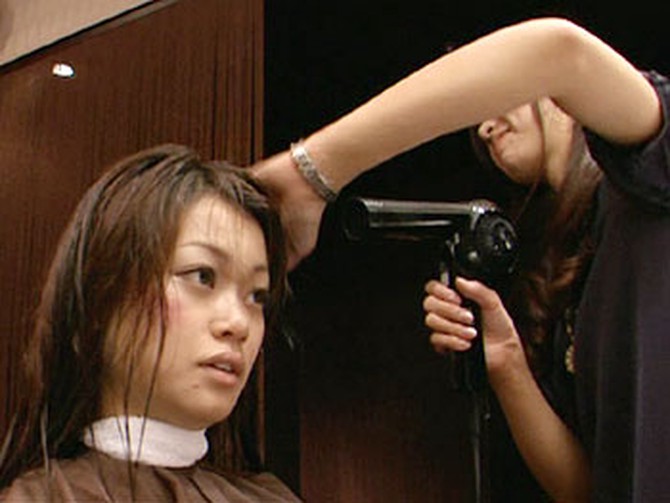
One beauty treatment that was developed in Japan is now used by women around the world. Known as Japanese hair straightening, hair correcting or thermal reconditioning, this technique uses chemical creams and flat irons to straighten wavy hair. "It's a way of taking hair that's naturally wavy or a little bit kinky—something that you could blow straight—but just for convenience' sake, you permanently make it straight," Mara says.
In Japan, straight hair is considered "the norm," and therefore, more attractive.
As an African-American woman, Mara says she's had her hair straightened or relaxed using similar techniques, but she didn't think it was common in Asian countries. "We go through a lot to straighten," she says. "I was a little surprised to find that Asian women are also using chemicals and heat to straighten their hair."
In Japan, straight hair is considered "the norm," and therefore, more attractive.
As an African-American woman, Mara says she's had her hair straightened or relaxed using similar techniques, but she didn't think it was common in Asian countries. "We go through a lot to straighten," she says. "I was a little surprised to find that Asian women are also using chemicals and heat to straighten their hair."

In America, late-night infomercials advertise products that claim to perform cosmetic miracles. Whether you want to get rid of cellulite or sculpt your abs, there's something out there for you. In Japan, women are faced with a different barrage of products.
Mara brought a few back to Chicago to show Oprah and her audience. The first is a Japanese contraption that's advertised as a face-slimming belt. "If anyone's concerned that your face may be too puffy or chubby or whatever, this is a belt that you can wrap around your face. It's supposed to make your face thinner," Mara says. "It kind of has sauna properties, supposedly. So it may sweat out some bloat[ing], possibly. It's supposed to heat things up and make you sweat a little bit."
The next product is a face-whitening cream that many women, including Miyuki, use on a regular basis. Mara says this cream claims to lighten a person's complexion. "You see a lot of products that advertise whitening because [Japanese women] want that porcelain, that very, very fair, light skin," Mara says.
Mara brought a few back to Chicago to show Oprah and her audience. The first is a Japanese contraption that's advertised as a face-slimming belt. "If anyone's concerned that your face may be too puffy or chubby or whatever, this is a belt that you can wrap around your face. It's supposed to make your face thinner," Mara says. "It kind of has sauna properties, supposedly. So it may sweat out some bloat[ing], possibly. It's supposed to heat things up and make you sweat a little bit."
The next product is a face-whitening cream that many women, including Miyuki, use on a regular basis. Mara says this cream claims to lighten a person's complexion. "You see a lot of products that advertise whitening because [Japanese women] want that porcelain, that very, very fair, light skin," Mara says.
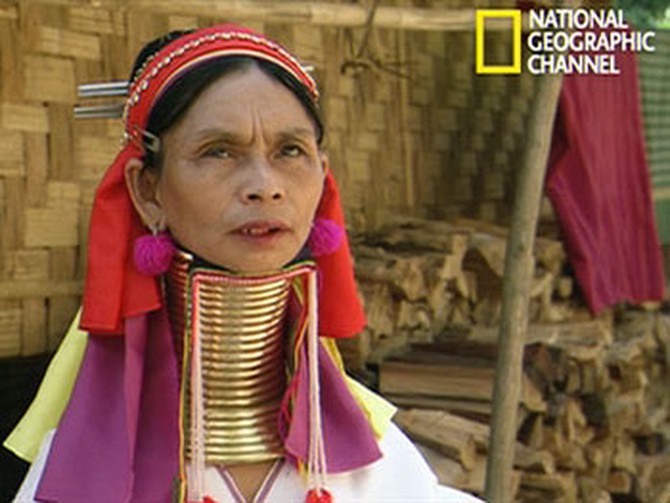
Clear skin and straight hair might make a woman more attractive in Japan, but in remote corners of the globe, women are judged by different criteria. On the National Geographic Channel's show Taboo, cameras document some of the world's most extreme beauty practices.
On the border of Burma and Thailand, members of the Kayan tribe begin their beauty rituals at a young age. At just 5 years old, girls start wearing brass rings around their necks, a ritual that's centuries old. As they grow older, more rings are added, and eventually, their necks start to look elongated, giving them a giraffe-like appearance. For these women, the shiny brass rings are the ultimate sign of female elegance and status. Some neck pieces can weigh up to 22 pounds.
"If I take the rings off now, I won't look nice anymore," one woman says. "They really are a part of my life."
On the border of Burma and Thailand, members of the Kayan tribe begin their beauty rituals at a young age. At just 5 years old, girls start wearing brass rings around their necks, a ritual that's centuries old. As they grow older, more rings are added, and eventually, their necks start to look elongated, giving them a giraffe-like appearance. For these women, the shiny brass rings are the ultimate sign of female elegance and status. Some neck pieces can weigh up to 22 pounds.
"If I take the rings off now, I won't look nice anymore," one woman says. "They really are a part of my life."
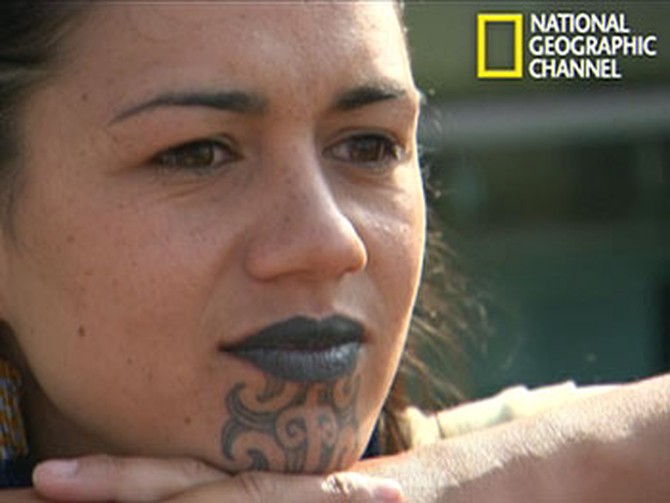
Thousands of miles away from the border of Burma and Thailand, the Maori people of New Zealand practice a sacred beauty ritual—tattooing.
These indigenous people, who are of Polynesian descent, believe women are more attractive when their lips and chins are tattooed. A woman with full, blue lips is considered the most beautiful and desirable.
These indigenous people, who are of Polynesian descent, believe women are more attractive when their lips and chins are tattooed. A woman with full, blue lips is considered the most beautiful and desirable.
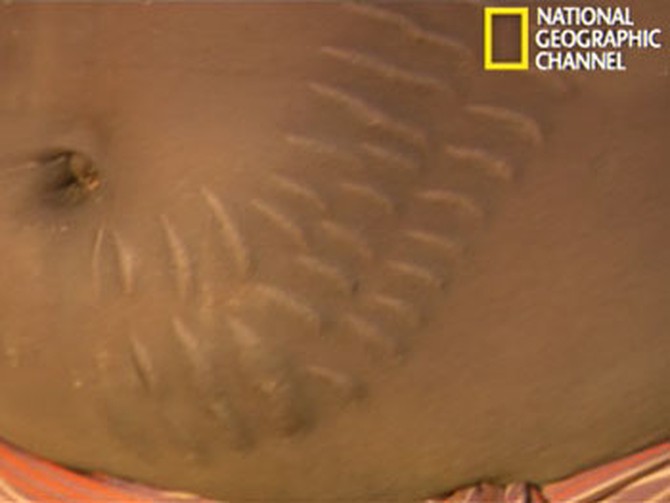
For the women of the Karo tribe in southern Ethiopia, beauty is literally skin deep. During childhood, girls allow their elders to cut scars onto their stomachs.
"The main reason for my scars is to attract a male that will give me joy, because I will be beautiful and hopefully get a husband," says one girl during her Taboo interview.
Once a Karo girl has received the last of her scars, she's allowed to marry and have children.
"The main reason for my scars is to attract a male that will give me joy, because I will be beautiful and hopefully get a husband," says one girl during her Taboo interview.
Once a Karo girl has received the last of her scars, she's allowed to marry and have children.
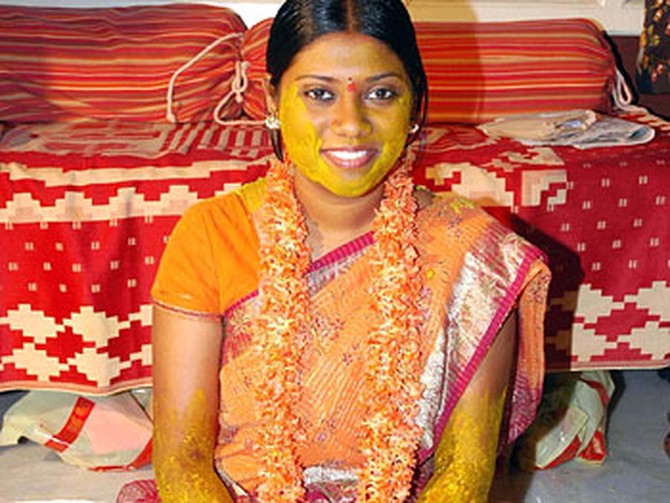
In India, women take a more natural approach to beauty. Ramya, a young woman from Bangalore, India, says some use homemade remedies to beautify themselves. On her wedding day, an Indian bride may use a mixture of turmeric, lemon and honey on her skin to achieve a glowing complexion.
Ramya says brides also wear special clothing and jewelry, including a forehead chain, on their special days. A dot of red powder on the face—known as a kumkum—is also thought to make a woman more attractive.
Around the world, Indian women are known for their beautiful skin and hair, and in the United States, women go to great lengths to achieve the same thick, shiny locks. To help American women achieve this look, salons offer hair extensions and weaves, a common practice that's grown into a multibillion-dollar business. What most women don't know is that their weaves may be coming from a sacred place.
Ramya says brides also wear special clothing and jewelry, including a forehead chain, on their special days. A dot of red powder on the face—known as a kumkum—is also thought to make a woman more attractive.
Around the world, Indian women are known for their beautiful skin and hair, and in the United States, women go to great lengths to achieve the same thick, shiny locks. To help American women achieve this look, salons offer hair extensions and weaves, a common practice that's grown into a multibillion-dollar business. What most women don't know is that their weaves may be coming from a sacred place.

For the past eight years, Angie has been wearing extensions, but she says she's never thought about where the hair originates. Each year, Mara says more than 1,000 tons of human hair are imported into the United States and used to create extensions and weaves. "Some of the best quality and most desirable hair comes from India," she says.
Where do they get all these long locks? Some of it originates at the Venkateswara Temple in southern India, one of Hinduism's holiest sites. Many of the worshipers who visit this temple leave a special offering for Lord Venkateswara—their hair. "It's part of a ritual called tonsuring, the cutting of hair for religious reasons," Mara says. "Every day, thousands of Hindus sit before the temple barbers to offer their hair and please the God."
Annually, Mara says the temple earns about $18 million selling this hair to exporters. "As soon as the hair leaves the devotee's head, it starts the journey to someone else's," she says.
New York City stylist Jay Ferrara uses "temple hair" in his extensions. "When this hair comes from India, it's beautiful," he says. For short extensions, Jay says he charges clients $2,000, and if you want longer hair, it will cost you as much as $4,000.
Mara says temple hair accounts for just 25 percent of the Indian hair market. The rest comes from women who collect the hair that comes out naturally and sell it. "It's called the dead hair market," Mara says. "You may have 60 women in one village who pool their hair together, and they'll sell it for $2. So they're getting pennies for this."
Where do they get all these long locks? Some of it originates at the Venkateswara Temple in southern India, one of Hinduism's holiest sites. Many of the worshipers who visit this temple leave a special offering for Lord Venkateswara—their hair. "It's part of a ritual called tonsuring, the cutting of hair for religious reasons," Mara says. "Every day, thousands of Hindus sit before the temple barbers to offer their hair and please the God."
Annually, Mara says the temple earns about $18 million selling this hair to exporters. "As soon as the hair leaves the devotee's head, it starts the journey to someone else's," she says.
New York City stylist Jay Ferrara uses "temple hair" in his extensions. "When this hair comes from India, it's beautiful," he says. For short extensions, Jay says he charges clients $2,000, and if you want longer hair, it will cost you as much as $4,000.
Mara says temple hair accounts for just 25 percent of the Indian hair market. The rest comes from women who collect the hair that comes out naturally and sell it. "It's called the dead hair market," Mara says. "You may have 60 women in one village who pool their hair together, and they'll sell it for $2. So they're getting pennies for this."

In the Middle Eastern country Oman, women turn to nature as their source of beauty. Hashima, an Omani, says women like to put dried rose petals into boiling water and rinse their hair with it. "This gives the hair a very fine smell of a rose," she says.
Omanis even have an all-natural approach to dental hygiene. "The miswak stick is brushed on the teeth like a toothbrush," Hashima says. "It reacts with the human spit and gives an orange color to the lips."
Hashima says the more color a fabric or piece of jewelry has, the more beautiful it is. However, the brightly colored dresses are often covered by a cloaklike wrap called an abaya. "This is to cover up the woman's body, and it covers also if you had a bad hair day," she says.
While it's not mandatory in Oman, some women also wear a burqa, which veils the face. "It's used as a sign of beauty," she says. "It's supposed to make your eyes look really sexy."
Omanis even have an all-natural approach to dental hygiene. "The miswak stick is brushed on the teeth like a toothbrush," Hashima says. "It reacts with the human spit and gives an orange color to the lips."
Hashima says the more color a fabric or piece of jewelry has, the more beautiful it is. However, the brightly colored dresses are often covered by a cloaklike wrap called an abaya. "This is to cover up the woman's body, and it covers also if you had a bad hair day," she says.
While it's not mandatory in Oman, some women also wear a burqa, which veils the face. "It's used as a sign of beauty," she says. "It's supposed to make your eyes look really sexy."

Brazilians have long been regarded for their beauty, but some say achieving perfection has become a national obsession. Ilana Rehavia, a BBC radio reporter and native Brazilian, has an inside perspective. "Growing up in Brazil, I used to feel pretty inadequate about the way I looked and about my body," she says. "Being such close proximity with the beach also didn't help."
The average weight of a Brazilian woman is 110–125 pounds—and the pressure to be thin leads many people to take extreme measures. "Brazil is the biggest consumer of diet pills in the world," Ilana says. Brazilians also love to be fit—and it shows. Luciona, a personal trainer, says women of all ages are taking their bodies seriously. "In the past, only single girls would take such good care of their bodies," she says. "But in recent years, married women with children, they are really working at it."
For women who can't achieve their ideal body naturally, Ilana says plastic surgery is becoming more and more common. "Brazil has about three or four magazines specialized only in plastic surgery," she says. The country is now second only to the United States in the number of plastic surgeries performed. "Before, it used to be all about the butt," Ilana says. "Now, it seems Brazilian girls are concentrating a lot more on having really big breasts."
The average weight of a Brazilian woman is 110–125 pounds—and the pressure to be thin leads many people to take extreme measures. "Brazil is the biggest consumer of diet pills in the world," Ilana says. Brazilians also love to be fit—and it shows. Luciona, a personal trainer, says women of all ages are taking their bodies seriously. "In the past, only single girls would take such good care of their bodies," she says. "But in recent years, married women with children, they are really working at it."
For women who can't achieve their ideal body naturally, Ilana says plastic surgery is becoming more and more common. "Brazil has about three or four magazines specialized only in plastic surgery," she says. The country is now second only to the United States in the number of plastic surgeries performed. "Before, it used to be all about the butt," Ilana says. "Now, it seems Brazilian girls are concentrating a lot more on having really big breasts."

Beauty even takes priority in the poorest neighborhoods, like Rocinha. "It is the biggest slum in Brazil, and although women here earn a lot less, you can find as many beauty salons here as you'll find anywhere else in the city," Ilana says.
Although many Brazilians have dark, wavy hair, Ilana says the new trend is blonde, straight hair. "People will go to great lengths to highlight their hair and have permanent straightening," she says. Ilana walks into a salon in Rocinha and finds a woman who says she spends nearly half her salary on beauty treatments!
Although many Brazilians have dark, wavy hair, Ilana says the new trend is blonde, straight hair. "People will go to great lengths to highlight their hair and have permanent straightening," she says. Ilana walks into a salon in Rocinha and finds a woman who says she spends nearly half her salary on beauty treatments!
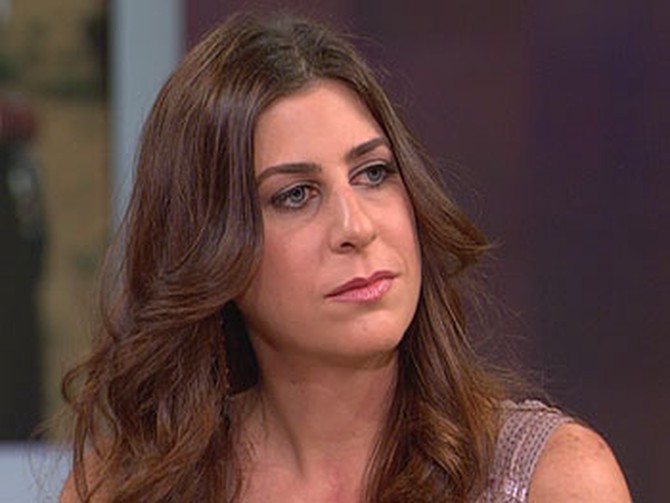
With so much pressure to be big-breasted, blonde and beautiful, it's no surprise that Ilana thinks many women struggle with self-esteem issues. "Brazilian girls, we don't feel happy if we're not pretty," she says. "That's the truth."
Ilana now lives in England, but when she travels back to Brazil, she says it's not uncommon for people to comment on her weight—whether she's taken some pounds off or put some on. "People don't feel awkward talking to you about your weight at all, which is quite interesting," she says.
Brazilians aren't alone in their quest for outer beauty. In a survey about body image conducted by Dove, 90 percent of the women they polled around the globe admitted they want to change some part of their appearance. A quarter of the women surveyed said they would consider plastic surgery, but just 2 percent have gone under the knife. When the women were asked if beauty is too narrowly defined by physical appearance, 70 percent said yes.
Ilana now lives in England, but when she travels back to Brazil, she says it's not uncommon for people to comment on her weight—whether she's taken some pounds off or put some on. "People don't feel awkward talking to you about your weight at all, which is quite interesting," she says.
Brazilians aren't alone in their quest for outer beauty. In a survey about body image conducted by Dove, 90 percent of the women they polled around the globe admitted they want to change some part of their appearance. A quarter of the women surveyed said they would consider plastic surgery, but just 2 percent have gone under the knife. When the women were asked if beauty is too narrowly defined by physical appearance, 70 percent said yes.

Irma lives in Jakarta, Indonesia, and says women in her country have a solution to getting their shape back after giving birth. She says women will wrap fabric called a stagen, which is 65 feet long, around the body to bind the women's belly.
"It is a bit painful, but I think what it does is to give the pressure to our womb to get back into the normal size," Irma says.
"It is a bit painful, but I think what it does is to give the pressure to our womb to get back into the normal size," Irma says.
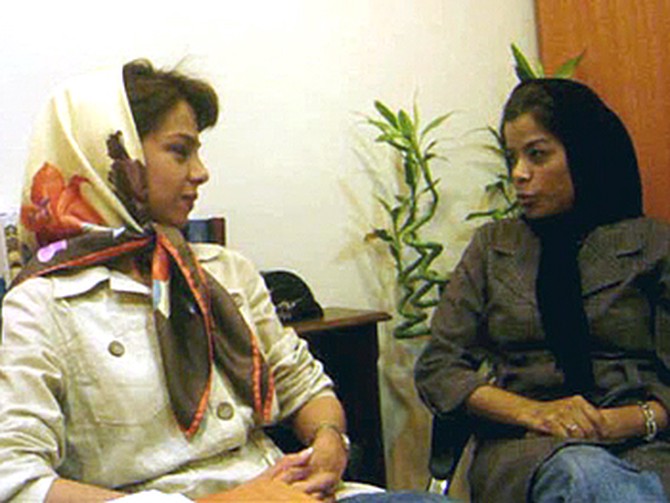
Can you guess which country has been dubbed "the nose job capital of the world"? It's not image-conscious Brazil or even the United States. It's Iran—the conservative Muslim country with seemingly endless contradictions. In a place where women cover most of their bodies, business is booming for plastic surgeons—they're performing an estimated 60,000 nose jobs a year.
While plastic surgery is kept hush-hush in many places, Iranian women like Naeimeh and Sahar are eager to talk openly about the procedure. "Here in Iran, women do have to cover their hair and the most beautiful part of their body," Naeimeh says. "They have to reveal their beauty out from a place which everybody can observe, which is the face."
After surgery, nose bandages are worn openly like badges of honor. Sahar says the surgery is so expensive in Iran, women see the bandage as a status symbol. "I had a friend who had a nose job, and she kept the bandage, if I'm not wrong, after two years on her nose just to show everybody that she had nose job," Sahar says. Pharmacists in Iran say nose jobs are so desirable, people who haven't had the operation still buy tape for their noses.
While plastic surgery is kept hush-hush in many places, Iranian women like Naeimeh and Sahar are eager to talk openly about the procedure. "Here in Iran, women do have to cover their hair and the most beautiful part of their body," Naeimeh says. "They have to reveal their beauty out from a place which everybody can observe, which is the face."
After surgery, nose bandages are worn openly like badges of honor. Sahar says the surgery is so expensive in Iran, women see the bandage as a status symbol. "I had a friend who had a nose job, and she kept the bandage, if I'm not wrong, after two years on her nose just to show everybody that she had nose job," Sahar says. Pharmacists in Iran say nose jobs are so desirable, people who haven't had the operation still buy tape for their noses.
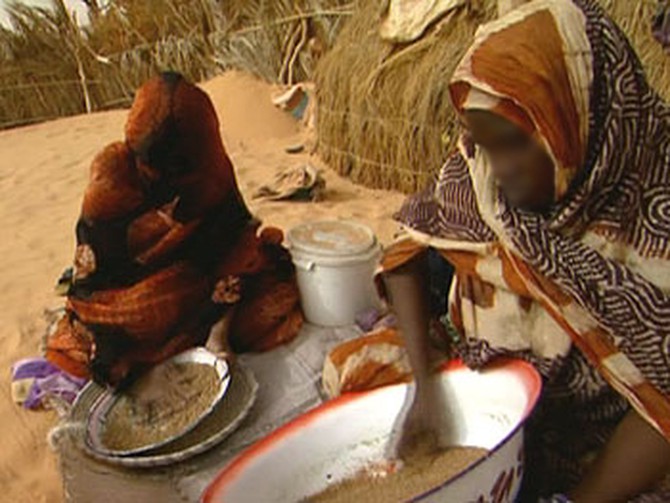
Courtesy of Al Jazeera English
In the United States and many countries around the world, thin is the standard when it comes to beauty. But in a West African country halfway around the world, bigger is definitely better. Mauritania is a desert oasis that sits on the northwest coast of Africa. Here, a woman's beauty is revered—but thin isn't in. In Mauritania, plump is sexy!
While it might sound nice to throw dieting out the window, it's not all pleasant. For generations, young girls were subjected to the practice of gavage—or force feeding—in order to fatten them up and make them more desirable. In Mauritania, many say the more you weigh, the better chances of you have of finding a husband.
Although force feeding is now frowned upon by the government, old habits die hard in remote areas of the country. Some young girls spend hours each day in the stifling heat, forced to stuff themselves with couscous and high-fat camel's milk. Vomiting only leads to another helping of food.
Even in Mauritania's more progressive cities, some women are willing to do anything for a fuller figure, including buying black-market drugs meant for animals.
While it might sound nice to throw dieting out the window, it's not all pleasant. For generations, young girls were subjected to the practice of gavage—or force feeding—in order to fatten them up and make them more desirable. In Mauritania, many say the more you weigh, the better chances of you have of finding a husband.
Although force feeding is now frowned upon by the government, old habits die hard in remote areas of the country. Some young girls spend hours each day in the stifling heat, forced to stuff themselves with couscous and high-fat camel's milk. Vomiting only leads to another helping of food.
Even in Mauritania's more progressive cities, some women are willing to do anything for a fuller figure, including buying black-market drugs meant for animals.

Houda, a woman who grew up in Mauritania, says her father is a doctor who sees the negative effects of the country's big idea of beauty. "My father deals every day with women with serious, serious health issues such as high blood pressure," she says. Even though the problems associated with obesity, like high blood pressure, heart disease and diabetes are prevalent, Houda says that doesn't deter women from wanting a big body. "When you're skinny, you're even considered as sick or there's something wrong with you," she says. "Women that are fat, they're really happy."
Thick ankles, plump arms and a big butt are considered the most beautiful parts of a woman, Houda says. And don't worry if you have a few stretch marks—the men in Mauritania love 'em!
Not only are extra pounds considered sexy—Houda says being divorced will win you extra points with the men too! "In Mauritania, you just get divorced and there's a feast, a party—and the more you get divorced, the more you're seductive," Houda says. "That means that a lot of men want to be with you."
"So if you are divorced with stretch marks and a big butt, Mauritania is calling your name!" Oprah jokes.
Thick ankles, plump arms and a big butt are considered the most beautiful parts of a woman, Houda says. And don't worry if you have a few stretch marks—the men in Mauritania love 'em!
Not only are extra pounds considered sexy—Houda says being divorced will win you extra points with the men too! "In Mauritania, you just get divorced and there's a feast, a party—and the more you get divorced, the more you're seductive," Houda says. "That means that a lot of men want to be with you."
"So if you are divorced with stretch marks and a big butt, Mauritania is calling your name!" Oprah jokes.
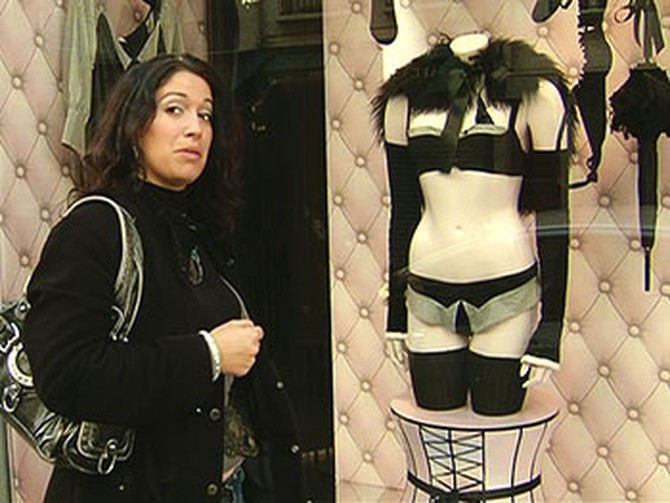
Paris, the City of Lovers, knows a thing or two about sexiness. And for Parisians, slender is sexy. Stephanie grew up in St. Pierre and Miquelon, a French island off the coast of Canada and now lives in Paris. "I've fortunately lost a bit of weight recently, but I used to have a hard time finding clothing in Paris stores because they go up to size 12," she says.
Stephanie says the goal of most Parisian women is to look effortlessly chic. "For French women, being beautiful is all about being elegant but in a natural, very subtle way." But how do French women get this je nais se quoi? "French women don't like to admit it, but, in fact, they spend a lot of time and money on beauty products for every part of their body," Stephanie says.
Watch Stephanie's report on Parisian sex appeal.
Once the body is perfectly moisturized and the complexion is flawless, Stephanie says the next step to sexiness is lingerie. "It's all about feeling good from the inside," she says.
In France, Stephanie says women look forward to getting older—turning 60 is sexy! At the same time, Stephanie says women keep up appearances and stay slim, trim and well groomed as they age. "French women feel entitled to be sexy and desirable all along their lives," she says. "It's a lot of work, but they feel entitled to it."
Stephanie says the goal of most Parisian women is to look effortlessly chic. "For French women, being beautiful is all about being elegant but in a natural, very subtle way." But how do French women get this je nais se quoi? "French women don't like to admit it, but, in fact, they spend a lot of time and money on beauty products for every part of their body," Stephanie says.
Watch Stephanie's report on Parisian sex appeal.
Once the body is perfectly moisturized and the complexion is flawless, Stephanie says the next step to sexiness is lingerie. "It's all about feeling good from the inside," she says.
In France, Stephanie says women look forward to getting older—turning 60 is sexy! At the same time, Stephanie says women keep up appearances and stay slim, trim and well groomed as they age. "French women feel entitled to be sexy and desirable all along their lives," she says. "It's a lot of work, but they feel entitled to it."
Keep Reading
Published 11/20/2008




